We both experienced a feeling of melancholy as we left Canada. There was so much of it we had not seen and we weren’t sure when we would be back. However the Montana border guard’s cheerful “welcome home” brought with it a sense of relief. We looked forward to reasonable gas and food prices (dispensed in gallons and ounces) and economical cell phone coverage. And then there was the simple pleasure of speed limits posted in miles per hour rather than kilometers. We never quite got used to those speed limit signs with “100” on them.
Where we have been - Glacier National Park in Montana and Alpine Lakes Wilderness in Washington
10/4 - 10/24 2010
In this post:
- Backpack trip – 4 day/3 night backpack trip along the Continental Divide Trail across Pitamakan and Triple Divide Passes
- Backpack trip – 3 days/2 nights to the Enchantments in the Alpine Lakes Wilderness, Washington
Our first stop was Glacier National Park where we did a 4 day/3 night backpack trip. The trail took us through Pitamakin Pass and then Triple Divide Pass on the Continental Divide past Triple Divide Peak. Water running off the 3 sides of this peak will eventually flow into 3 oceans; the Atlantic, the Pacific, and the Arctic (via the Hudson River).
Jean beginning descent down the Hudson Creek side of Triple Divide Pass in Glacier National Park, Montana
Shorter days, a side trip, a cross country “short cut”, and time consuming stream crossings (in anticipation of heavy snows the park service had already rolled up the slats across several suspension bridges so we were forced to rely on water shoes and horse fords to wade across )...
One of several water crossings we encountered but at least we got to do this one in daylight. Glacier National Park, Montana
...all led to us, against park service advice, to be hiking after dark. We have done quite a bit of nighttime hiking so are familiar with the sensation of having one’s universe shrink to the diameter of a headlamp beam.
All went well until John heard a “snort” nearby and in the dusk we were able to pick out 2 moose, a bull and cow, in the woods nearby. I almost would have preferred it to be a bear as this was the height of rutting season and moose are very territorial and considered to be more dangerous. Fortunately this bull did not see us as a threat so we were allowed to pass unharmed.
Later on we saw 2 sets of eyes glowing eyes in the dark (reflecting off our headlamps). We briefly saw the outlines of 2 more moose but lost sight when they turned away from us. It was impossible to tell if they were ahead of us on the trail (animals prefer using open trails over bushwhacking just as we do) or off in the woods. We didn’t believe we could safely leave the trail and circumvent the area, the standard advice when encountering large wildlife in the backcountry. So we stuck close together, alert and prepared to jump behind trees if this bull charged us, and inched our way down the trail. We eventually became a little more confident that they weren’t on the trail in front of us and picked up speed.
We much rather see these guys like this - in the distance and in the daylight. Red Eagle Lake in Glacier National Park, Montana
Later still, as we approached our destination for the night, we could hear elk bugling in the distance and the sound of splashing in a nearby lake evidently made by something large walking through it (most likely another moose). We gratefully found our campsite and a passable source for water. I felt emotionally “raw” and after eating supper I welcomed the illusion of safety that our tent provided. We so enjoyed waking up in daylight, being able to see our surroundings and hiking out under a clear sunny sky. All of our photos from this backpack trip are on Flickr.
We left Glacier and made our way west to Washington State. We did a day hike to Ingalls Lake, an old favorite destination in the North Cascades. All of our photos from this dayhike are on Flickr.
In addition John did a 3 day/2 night backpack trip to The Enchantments, another one of our favorite places (I was sidelined with a bad cold and very disappointed to not be able to go). All of our photos from this backpack trip are on Flickr.
Mt Rainier seen from the Ingalls Lake Trail in the North Cascades, Washington
In addition John did a 3 day/2 night backpack trip to The Enchantments, another one of our favorite places (I was sidelined with a bad cold and very disappointed to not be able to go). All of our photos from this backpack trip are on Flickr.
We then made our way over the Cascade Mountains, encountering snow in Stevens Pass, to spend several weeks in the Seattle area. I needed to get some surgery on my right foot (necessary but definitely not my idea of a good time). We also plan to spend the holidays with our sons, Dan (in Portland) and Tom (in Seattle). Where to after that? We can decide that later!
Hiking and backpacking is what we love to do and after so many years and so many trails we have experienced a wide variety of trail surfaces and conditions.
The most common trail surface is dirt which can be quite easy on the feet (and, depending on your personal “hiking style”, other body parts as well).
The most common trail surface is dirt which can be quite easy on the feet (and, depending on your personal “hiking style”, other body parts as well).
Tom “hiking” the Summerland Trail in Mt Rainier National Park, Washington
A downside to smooth dry dirt is that it can be unpleasantly dusty with the least bit of wind. Dust can also be kicked up by a hiker’s boots (and again, depending on your personal “hiking style”, other body parts as well). However dirt trails are oftentimes marred with roots and rocks which have a propensity for tripping inattentive hikers by reaching up and grabbing a boot. Then again dirt trails covered in conifer needles can be soft and “springy”, like hiking on pillows.
But where there’s dirt there can be mud. On level ground mud can be quite deep. In Jasper National Park we read with interest a trail report, on a trail we would be taking to the Tonquin Valley, where a woman described in great length about sinking up to her knees in mud. On steep ground mud is merely slippery.
Jean on the Lazy Mt Trail in Palmer, Alaska
Gravel can make a great trail surface; durable, non dusty, non muddy, but is unfortunately expensive and labor intensive for parks to install. Normally I must watch my footing carefully (so I’m a little clumsy and fall down sometimes) but gravel trails can be so good that can I take my eyes off the trail long enough to enjoy the views.
Mt Robson Provincial Park in BC Canada is reported to have the best maintained trails in the Canadian Rockies
Sand is a less common hiking surface and certain conditions, for example when it is deep and loose, can make it challenging…
Tom and Dan on the Oregon Coast
…however when well packed sand can make for an easy trail surface for hiking or...whatever.
Snow when not too deep can be fine to hike on but when slippery traction devices such as Yaktrax or Microspikes can be very helpful. Deep pristine snow can be "heavenly" providing one has snowshoes…
Jean snowshoeing in Mt Rainier National Park, Washington
Trails can also present a wide variety of obstacles that need to be negotiated. Steep terrain is one.
Tom along the Pacific Coast in Olympic National Park, Washington
Rocks are another. Sometimes they must be climbed over…
…sometimes crawled under,…
Dan in Buckskin Gulch, Utah
…and sometimes either will work.
Jean and Dan with “Jupiter’s Thunderbolt” in Lava Beds National Monument, California
Sometimes rocks are something one must rappel down ...
... or go between.
Occasionally rocks aren't so much obstacles to be negotiated as they are impediments to forward progress.
John on the Royal Arch Loop in Grand Canyon National Park, Arizona
... or go between.
Jean on the Joint Trail in Canyonlands National Park, Utah
Occasionally rocks aren't so much obstacles to be negotiated as they are impediments to forward progress.
Jean on the trail in the Mission Mountains, Montana
Another potential obstacle is water and unless one limits their hiking to desert areas it is inevitable that a trail will cross it. When water is shallow enough it is frequently easy to “rock hop” and maintain dry feet but deep water is another matter. Bridges are helpful…
Typical bridge encountered while trekking up the Khumbu Valley in Nepal
Jean wishing she didn't have to take her boots off...again, Glacier National Park Montana
…but in the absence of a bridge a tram is appreciated even if not enjoyed.
Crossing the Grewingk Creek in Kachemak Bay State Park, Alaska
Oftentimes in “shallower” water (meaning not over one’s head) no provisions are made to assist hikers. In those cases it is necessary for one to wade or even swim across. Stream and river crossings can be quite hazardous depending on the depth, strength of the current, temperature and clarity of the water...
As easy stream crossing in Denali National Park, Alaska
… or, depending on the consistency, they can merely be something that one has to get through. A good attitude can help.
Dan and one of the several “water” crossings encountered while backpacking through Buckskin Gulch, Utah
Living obstacles can be encountered along trails; some more challenging than others. Vegetation is generally not a problem on trails that are well maintained and frequently used. However it is a different story when trails aren’t maintained, or even present. National Parks in Alaska frequently don’t even have trails and while hiking in Denali we had opportunities to sink in deep sub arctic tundra and wet marshes as well as to bushwhack through thick brush. But bad as it was at least we didn’t encounter a menace common in the southwest US, the dreaded “Killer Cacti!”
Tom in Natural Bridges National Monument, Utah
When going into the backcountry the chance of encountering wildlife is always present. Especially in woody and brushy areas as animals prefer the ease of traveling down trails just as humans do. Hiking in “Bear Country” requires taking extra precautions such as making a lot of noise to encourage nearby bears to avoid you. In Banff National Park, BC major trails near Lake Louise are restricted to parties of at least 4 people who are required to hike in a tight group and stay within ~9 ft of each other. Individuals and groups of less than 4 must wait at the trail head and hook up with strangers (it makes those off trail pee breaks interesting). However, sometimes encounters are impossible to avoid such as when bears walk right through your camp.
Early morning visitors to our campsite on Eielson Pass in Denali National Park, Alaska
Moose and elk during rutting season are reported to be more dangerous than bears but by far the closest encounter we have had thus far with wildlife in the backcountry was with this “Attack Ptarmigan”.
This extremely aggressive ptarmigan attacked our ankles and chased us down the trail for at least 50 yards, Glacier National Park, Montana
We really do try not to complain too much about any of the assorted trail conditions we encounter as we, after all, have made the choice to be out there. We are well aware that while we hike trails for fun there are many individuals in other parts of the world who rely on trails to earn a living; those employed as porters carrying goods from one place to another. On the REI Adventures Everest Classic trek we took up the Khumbu Valley in Nepal we observed many Nepalese people; men, women and children, carrying unbelievable loads. Trekking up what seemed like a steep rough trail to us...
Jean trekking up the Khumbu Valley in Nepal
... was just another day at “the office” for them.When it's all said and done, our bottom line is if it’s in the backcountry then every trail is a “happy trail” especially when shared with those we love.
John, Dan and Tom in Yellowstone National Park, Wyoming

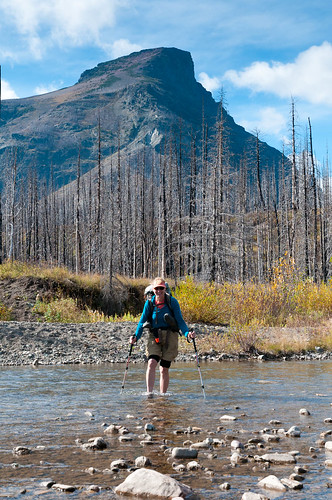
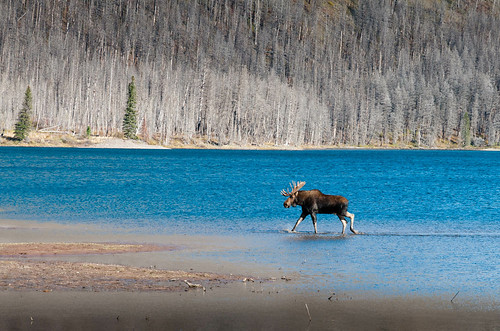
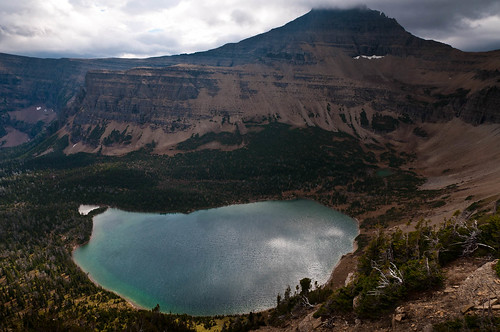



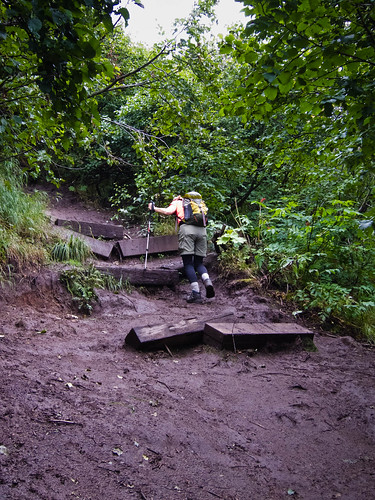
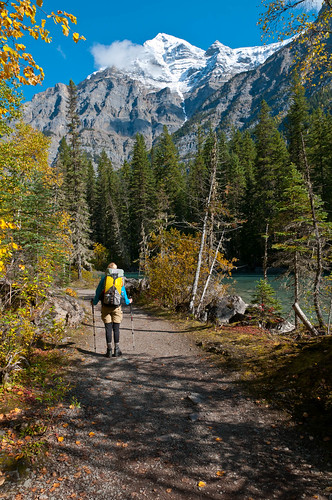








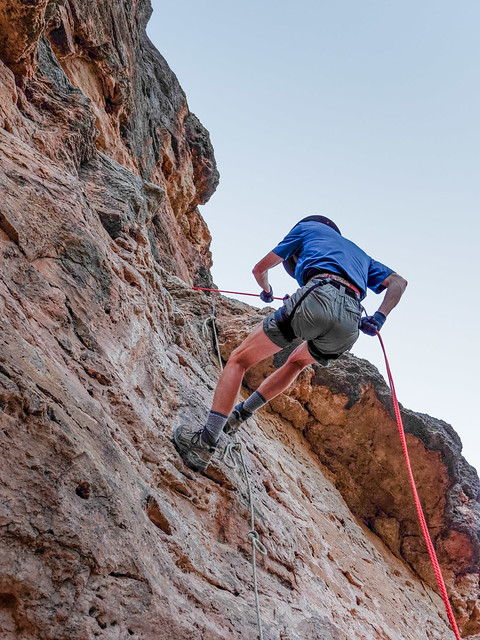



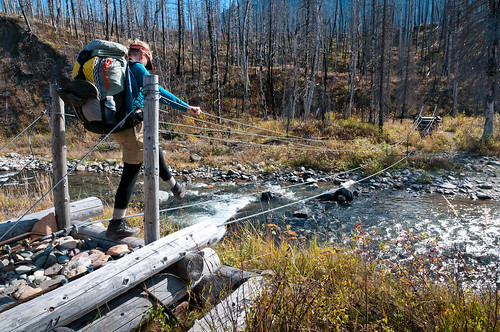
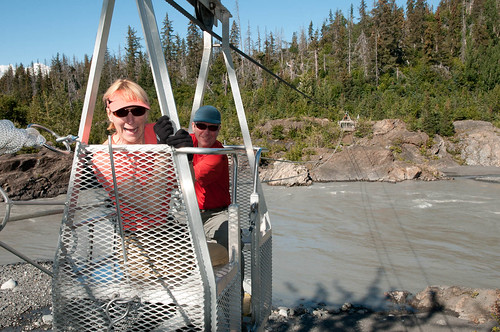
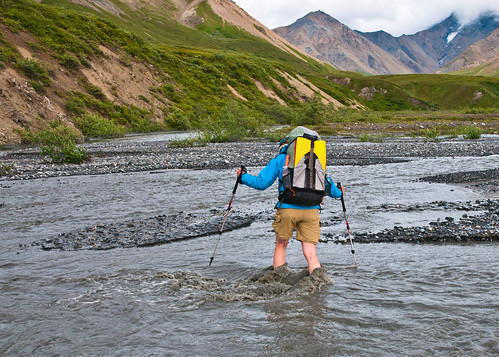
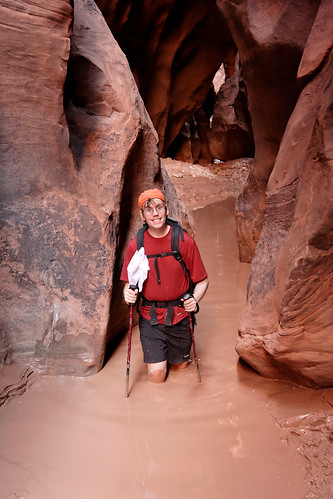

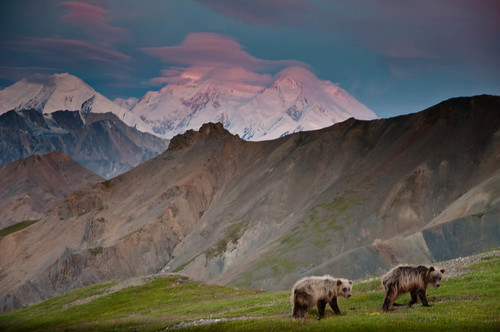








1 comment:
This is Tom Strother. I am the face-planter of snow, the conqueror of cacti, crawler of dirt, scaler of dunes, cliff hanger of cliffs, master of the brightly colored hat, and I, uh, could probably do that crazy 'fridge thing too. But most important of all, I am here to approve my brother's maniacal Buckskin Gulch water-wading smile and the impalement of some sort of rooster with not one, not two, but four trekking poles. This comment will be made visible after approval.
Post a Comment